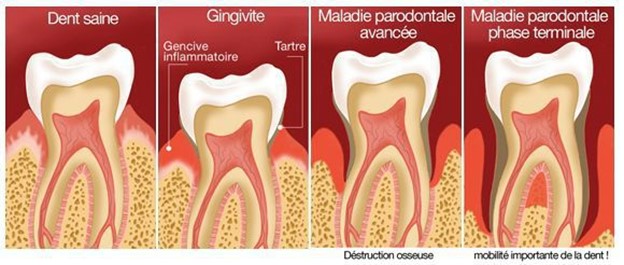 Gingival Therapy (Periodontics)
Gingival Therapy (Periodontics)
Does your gums bleed easily when brushing or flossing? Perhaps you suffer from gingivitis or even periodontitis. This is a form of inflammation of the soft and hard tissues surrounding the tooth.
What is periodontal disease?
Hundreds of different types of bacteria make up our oral flora. The main cause of periodontal disease is called porphyromonas gingivalis. This type of bacteria is found in the salivary flow and under the gums. Every day, bacteria organize themselves to form a deposit on the teeth called biofilm or dental plaque. It is a soft deposit, which can easily be removed with good brushing combined with the use of dental floss or interdental brushes for more difficult to access areas. If not removed daily, this deposit calcifies with the help of minerals contained in saliva and forms a much harder deposit, called tartar. Once tartar is established, only dentists and hygienists can remove it, which is when this process is called scaling. It must be understood that in both cases, whether it is a soft deposit or a hardened deposit, it is a deposit of bacterial origin. Bacteria= inflammation!
Gingivitis is the first stage of periodontal disease. At this stage, the gums appear normal, but may also be red, swollen, and bleed easily when you brush your teeth. Bad breath can also be linked to this disease. This is the start of the infection. At this stage, a periodontal probe* can be inserted between the tooth and the gum, to a depth of approximately 1mm to 2 mm. This space is called the “periodontal pocket.”
* Dental instrument used to measure and evaluate depth of pockets surrounding the tooth.
The second stage of the disease is early periodontitis. At this point, the infection has spread from the gum to the jaw bone. The depth of the periodontal pocket can vary between 3mm to 4 mm. The deeper the pocket, the more the bacteria can penetrate, and the more the gum shrinks. This is when the root of the tooth becomes exposed and sensitivity to cold or touch may appear.
The third stage is moderate periodontitis, in which case the root of the tooth can be seen very well. At this point, it is possible that a third of the bone has been lost. The depth on the probe, when inserted into the periodontal pocket, can reach 5 to 6mm.
The fourth and final stage of the disease is advanced periodontitis. At this point, more than half of the bone has been lost and the pockets are very deep. The tooth then appears longer since the root is exposed. We are then talking about pockets of 7mm and more. The tooth continues to become loose and may eventually fall out. Otherwise, it will need to be extracted by your dentist.
To prevent these diseases, it is very important to brush your teeth, floss daily, and ensure good oral health through regular checkups at the dentist. If the disease is at a moderate or advanced stage, gingival curettage may be considered. It makes it possible to remove tartar and bacterial by-products under the gums and thus better control the organization and the inflammatory process linked to the biofilm. In addition, older or less well-fitting fillings and crowns can contain several types of bacteria, including those that cause periodontal disease. It will then be important to replace them.
Consult us for a complete periodontal evaluation and you will be able to receive personalized recommendations according to your oral condition.
